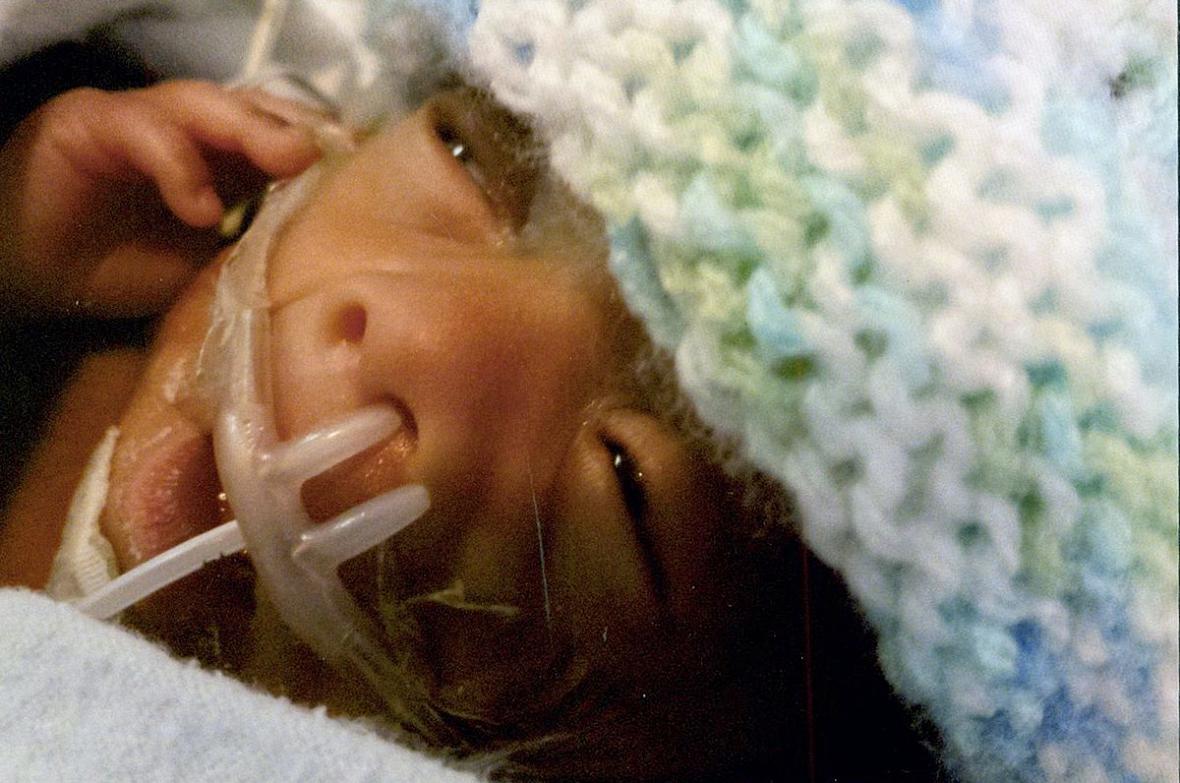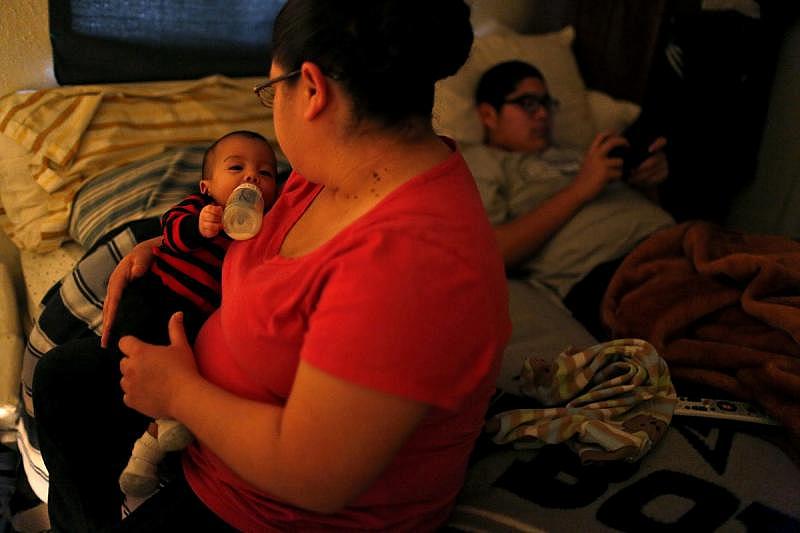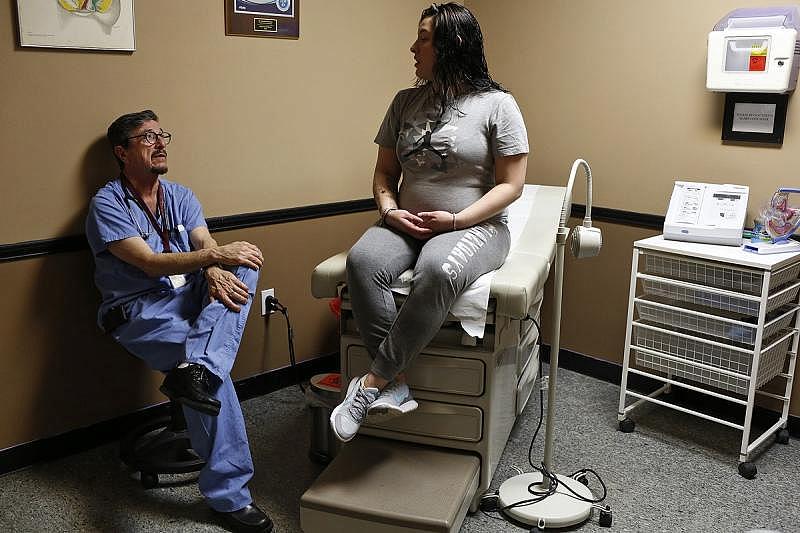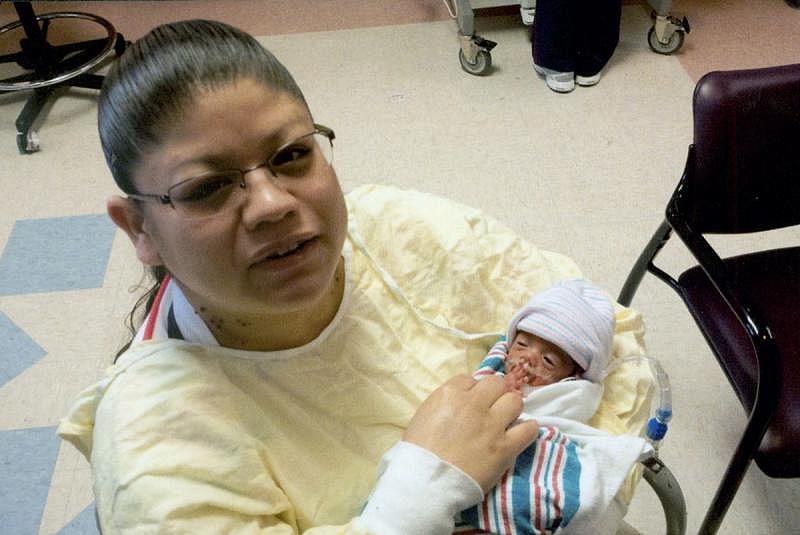Behind from the start: Prenatal care crisis puts babies in Bexar County, Tex., at risk — Part 1
This article is the first in a series of three articles on prenatal care in Bexar County, Texas, which were produced as a project for the National Health Journalism Fellowship, a program of the Center for Health Journalism at the USC Annenberg School of Journalism.
Other stories in the series include:
Behind from the start: Why some women aren't receiving early prenatal care — Part 2
Behind from the start: What can be done to help women receive prenatal care — Part 3

Chance Miracle Rodriguez spent more than three months in the neonatal intensive care unit after being born premature. His mother, Anita Solis, had high blood pressure and experienced preeclampsia while pregnant. (Courtesy Anita Solis)
Chance Miracle Rodriguez is almost a year old, but at less than 13 pounds, he still fits into some newborn-sized clothes.
Born four months premature, at just 1 pound and 9 ounces, Chance spent more than three months in the neonatal intensive care unit, a time his mother describes as an "emotional roller coaster — not knowing if he was going to make it."
While the brown-eyed boy with a sweet smile survived — and is even thriving — not all premature babies do.
His mother, Anita Solis, gave birth to Chance after she experienced a sudden spike in blood pressure, or preeclampsia, and was flown by helicopter to University Hospital. The emergency Caesarean section was the first time Solis saw a doctor after becoming pregnant, despite having a history of high blood pressure, because she had no health insurance.
When he was born Jan. 28, Chance joined thousands of babies born every year in Bexar County to mothers who received no prenatal care. Those women are more likely to give birth prematurely, increasing the odds that their newborns will develop immediate and long-lasting health problems that can be both costly and fatal.
The series
In 2013, San Antonio's rate of premature births, 11.5 percent, ranked first among the largest cities in Texas and was among the highest in the country, where the national average is 9.6 percent. Experts say barriers to medical care contribute to the problem.
In recent years, the prenatal care deficit has grown worse in Bexar County, a trend undetected by local health officials until they were asked about it by the Express-News for this series.
Nearly one in every six women, or 15.4 percent, who gave birth in Bexar County received no prenatal care in 2014. That’s up from about one in 40, or 2.7 percent, just three years earlier, according to the most recent figures from the San Antonio Metropolitan Health District. By contrast, the rate for Texas overall was 4.6 percent in 2013.
Add the nearly 4,000 pregnant women who didn’t get any care with the more than 6,000 pregnant women who received care late in pregnancy — after the first trimester — and the rate hits a staggering 39 percent of all live births in Bexar County in 2014.
"It’s a significant issue in our community," said Dr. Thomas Mayes, head of pediatrics at the UT Health Science Center. “In a country that has a wonderful health system, there should be virtually nobody that doesn’t get prenatal care. Nobody.
“Richest country in the world, and we have this kind of rate. It’s just a travesty, to be honest with you.”
Women who are Hispanic, black or low-income are more likely to encounter barriers to getting care and suffer the consequences.
For example, on the near West Side, including the 78207 ZIP code, more infants die before their first birthday than in many other areas of San Antonio. Also in that ZIP code, where 38.6 percent of families fall below the poverty level, half of all births — 525 out of 1,043 births in 2013 — were to mothers receiving late or no prenatal care.
That’s about double the percentage in the 78258 ZIP code, which encompasses much of the more affluent Stone Oak area.
While it’s impossible to say whether Solis’ emergency delivery of Chance Miracle — so named because he survived — could have been avoided had she received prenatal care, high blood pressure is a condition that should be treated and monitored during pregnancy because it can lead to premature birth.
“I just wish I could have had proper care when I needed it,” said Solis, 36, a single mom of three boys in Seguin. “Maybe he wouldn’t have been so little.”
None of the experts interviewed by the Express-News could explain why prenatal care fell off so dramatically from 2011 to 2014, when a total of 10,391 women didn’t see a doctor during their pregnancy. It might be related to changes in how such data is reported, said Texas state demographer Lloyd Potter.
It's possible that more women in the past didn’t get care, but the fact wasn’t recorded, Potter said. He pointed out that Metro Health data show that as the number of pregnant women not receiving care went up over four years, the number of women whose prenatal care status was marked as "unknown" went down.
If reporting is now more accurate, it means the severity of the problem was hiding in the data and for years has been worse than health officials thought.
In fact, the percentage of women getting no care might be higher still: In 2013 and 2014, six percent of births were to women whose prenatal care status was marked “unknown.” At least some of them, too, likely did not get care.
Anil Mangla, assistant director of health at Metro Health, told the Express-News that while the reporting of prenatal care likely is improving, he also believes more women aren’t getting the care they need. He isn’t sure why.

While an epidemic of congenital syphilis — caused by a mother who passes syphilis to her unborn child — prompted Metro Health a few years ago to examine why so many of those mothers weren't getting tested and treated for the disease before birth, health officials have not been investigating why some other pregnant women aren’t receiving care.
"Due to lack of resources, we can't study every public health concern we have," Mangla said last month. “Lack of resources, lack of staff, lack of money. There’s a lot of things that contribute to that.”
On Friday, Mangla, responding to inquiries from the Express-News, said Metro Health will convene a work group to look into the problem.
Making sure women get needed care is essential not just for babies but the community, said Dr. Alice Gong, a neonatologist at University Hospital and pediatrics professor at UT Health Science Center at San Antonio.
At a few thousand dollars, prenatal care costs less than treating sick babies and mothers. Half of all births to women with late or no prenatal care were paid for by Medicaid in 2014, so taxpayers foot the bill.
Premature births are “costing us lots and lots of money,” Gong said. “Now these women and these families are left with a very handicapped child, which makes things much worse for them. We as a society have to care for that child.”
Early care
Experts recommend all pregnant women get care as early as possible — ideally, as soon as they realize or suspect they're pregnant or in the first three months — and continue it through to birth.
Babies of women who don’t get prenatal care are three times more likely to have a low birth weight and five times more likely to die, according to the U.S. Department of Health and Human Services.
Bexar County falls far short of the target of Healthy People 2020, a federal initiative to promote health, which aims for 77.9 percent of women to begin prenatal care in the first three months of pregnancy. In Bexar County in 2014, only 61.4 percent of women began care by then.
"There's a significant number of women who are not going (for prenatal care) consistently," said Kelly Bellinger, an expert in maternal and child health and former director of Healthy Start, a Metro Health program focused on improving the health of babies and mothers.
“And so what that does is, it doesn’t give the doctor an opportunity to really evaluate her progression of her pregnancy.”
Prenatal care visits are for more than gender reveals and ultrasound photos for baby books.
Doctors can identify and treat maternal issues, such as diabetes, high blood pressure and sexually transmitted diseases, problems that can affect mother and baby. An untreated STD, such as HIV/AIDS or syphilis, can pass directly to the baby.
"Of the last four congenital syphilis cases I saw, three of the women had zero, I mean zero, prenatal care,” Mangla said.
For some women who can’t readily access health care otherwise, pregnancy is the only time they seek medical help or advice, making prenatal care appointments all the more crucial.

Prenatal care is essential for identifying high-risk pregnancies, said Dr. Abraham Alecozay, an OB-GYN with Southwest General Hospital.
“For a million years, women delivered babies in the field, everything went all right, we’re doing well, the species has still survived,” he said. “But the problem is, which (mother is) going to have high blood pressure? Which one (is) going to have diabetes?”
Early prenatal care “can help reduce not just complications for babies but can address important complications, severe complications, and death for women,” said Dr. Lisa Hollier, an OB-GYN at Texas Children’s Hospital in Houston and chair of the state health department’s maternal mortality and morbidity task force.
Women are three to four times more likely to die of pregnancy-related complications when they do not receive prenatal care, according to the Centers for Disease Control and Prevention.
When it’s time for delivery and a woman hasn’t seen a doctor before, the hospital medical staff faces a raft of unknowns.
“Women with no prenatal care often have chronic hypertension and gestational diabetes, things like that,” said Dr. Ometeotl Acosta, a maternal/fetal medicine specialist at UT Health Science Center at San Antonio. “But when they present to us, we have no clue and have got to figure that out. Usually we’ll ask a patient what their due date is. And they won’t know.”
Barriers to care
Lack of health coverage is a major impediment to getting prenatal care and a problem that disproportionately affects poor women, handicapping their children even before they're born and perpetuating health disparities.
Solis, a certified nursing assistant, said she couldn’t afford the health insurance offered by her employer, and she was waiting for approval of her Medicaid application so she could see a doctor when she had to be rushed to the emergency room.
The women receiving the least medical care during pregnancy are often the ones who need it most. Levels of hypertension are higher among African Americans, and obesity and diabetes are most common among Hispanics. Those conditions can lead to serious health problems for mothers and babies.
Aside from a lack of insurance, women miss out on prenatal care for a variety of reasons: They don’t have reliable transportation or child care, or they can’t miss work, making it difficult to keep up with appointments.

Undocumented immigrants and women who use illegal drugs often fear seeing a doctor, as do women in violent relationships. Many others don’t know they should seek medical care early in pregnancy. And then there are the teenage mothers-to-be who conceal their pregnancies for as long as possible.
Teens also are more likely to have unplanned pregnancies. Women whose pregnancies are unplanned and women who don’t have a regular health care provider before they get pregnant are less likely to get prenatal care in the first trimester of pregnancy.
Some experts have theorized that the Texas Legislature’s cuts to some women’s health care services in 2011 contributed to the increase of women receiving no prenatal care. While those cuts didn’t affect access to prenatal care, they did limit access to contraceptive services, said Helen Kent Davis, director of government affairs at the Texas Medical Association, possibly leading to more unplanned pregnancies.
While neonatal medicine has improved in recent decades, allowing doctors to save tinier premature babies, efforts to reduce prematurity through preventive care lag behind, Gong said.
"I’ve been in this field for 30 years and I’ve seen so many advances," she said. “But the same things that we talked about when I was in medical school, getting prenatal care, getting women healthy, those things? We haven’t done very much of that.”
Prematurity worse here
Chance was born at just 23 weeks gestation and spent more than three months in neonatal intensive care.
His mother recalled the fear and worry she felt during that time as she drove miles to see him, "not knowing if he was going to make it, having to go back and forth to see him, see him hooked up to all these machines, me not being able to help him."
Solis feels lucky that her son survived. Premature birth is one of the most serious after-effects associated with lack of prenatal care and the biggest contributor to infant death, according to the Centers for Disease Control and Prevention.
Those babies who live are at risk for breathing problems, hearing loss, intellectual disabilities, cerebral palsy and digestive problems. They're more likely to have learning and behavior problems that require special school services. Long-term health conditions might limit their ability to work as adults.
Besides the emotional toll of prematurity, the financial costs also are high to treat babies in a neonatal intensive care unit for days, weeks or months. The average medical cost for a healthy, full-term baby from birth through the first year is about $5,000. It’s more than $55,000 for a premature and low-birth weight baby, according to the March of Dimes.
Compare that with the average cost of prenatal care for an uncomplicated pregnancy, which Mike Koroscik, CEO of The Institute for Women's Health in San Antonio, calculated at $2,000 for about 12 appointments.
The high costs of prematurity can extend long past a baby’s first birthday. If children have lifelong medical problems or disabilities, they and their families could end up receiving state and federal assistance funded by taxpayers.
Such expensive care could have been avoided in some cases with early prenatal care.
For example, women who have had a premature birth can reduce the risk of having another by taking progesterone shots, which can cost as little as $10 to $15. That medication ideally is started between 16 and 20 weeks of pregnancy, said Hollier, the Houston doctor. If a woman starts prenatal care too late, she could miss an opportunity to prevent another premature birth.
Other consequences
Prenatal care also can identify women for factors that may increase the risk of what Dr. Rajam Ramamurthy calls one of the most difficult, traumatizing experiences for parents: stillbirth.
"When that happens, it's very devastating for the family," said Ramamurthy, a neonatologist.
High blood pressure and infections are risk factors for stillbirth. So is uncontrolled diabetes, a major problem in San Antonio. Latinas are 50 percent more likely than non-Hispanic Caucasian women to have gestational diabetes, according to the American Diabetes Association.
A pregnant woman's untreated diabetes can cause her baby to grow too large, said Acosta, the UT Health Science Center physician. That can mean a difficult or impossible vaginal delivery. The mother may need to undergo a Caesarean section, or the baby risks injury during delivery.
Babies born to diabetic mothers also may need to be treated for blood sugar problems, and overweight infants have an increased risk of becoming obese as young children. Diabetes in pregnancy can be monitored and controlled by a physician to prevent those problems.
As for Chance, while underweight for his age, he’s thriving despite his rocky start in life.
He takes medicine for his blood pressure and must eat prescription formula. Three times a month, an early childhood intervention specialist visits his family’s Seguin apartment to help with his delayed development. For his first birthday, he’ll get a cake. The family doesn’t have money for much else.
On their refrigerator hangs the name card from his hospital incubator, decorated with bulldozers and dump trucks. His mother still has one of the caps he wore during that time.
“That hat is so tiny,” Solis said. “When you first see it, you’re kind of sad. Then you start thinking, Thank God he’s OK. It could have gone a totally different way.”
[This story was originally published by San Antonio Express-News.]
Photos by Lisa Krantz /San Antonio Express-News.

